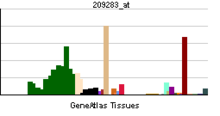CRYAB
| View/Edit Human | View/Edit Mouse |
Alpha-crystallin B chain is a protein that in humans is encoded by the CRYAB gene.[1] It is part of the small heat shock protein family and functions as molecular chaperone that primarily binds misfolded proteins to prevent protein aggregation, as well as inhibit apoptosis and contribute to intracellular architecture.[2][3][4] Post-translational modifications decrease the ability to chaperone.[2][4] Defects in this gene/protein have been associated with cancer and neurodegenerative diseases such as Alzheimer’s disease and Parkinson’s disease.[2][3][4]
Structure
Crystallins are separated into two classes: taxon-specific, or enzyme, and ubiquitous. The latter class constitutes the major proteins of vertebrate eye lens and maintains the transparency and refractive index of the lens. Since lens central fiber cells lose their nuclei during development, these crystallins are made and then retained throughout life, making them extremely stable proteins. Mammalian lens crystallins are divided into alpha, beta, and gamma families; beta and gamma crystallins are also considered as a superfamily. Alpha and beta families are further divided into acidic and basic groups.
Seven protein regions exist in crystallins: four homologous motifs, a connecting peptide, and N- and C-terminal extensions. Alpha crystallins are composed of two gene products: alpha-A and alpha-B, for acidic and basic, respectively. These heterogeneous aggregates consist of 30-40 subunits; the alpha-A and alpha-B subunits have a 3:1 ratio, respectively.[2]
Function
Alpha B chain crystallins (αBC) can be induced by heat shock, ischemia, and oxidation, and are members of the small heat shock protein (sHSP also known as the HSP20) family.[2][5] They act as molecular chaperones although they do not renature proteins and release them in the fashion of a true chaperone; instead, they bind improperly folded proteins to prevent protein aggregation.[2][3][4]
Furthermore, αBC may confer stress resistance to cells by inhibiting the processing of the pro-apoptotic protein caspase-3.[4] Two additional functions of alpha crystallins are an autokinase activity and participation in the intracellular architecture. Alpha-A and alpha-B gene products are differentially expressed; alpha-A is preferentially restricted to the lens and alpha-B is expressed widely in many tissues and organs. Elevated expression of alpha-B crystallin occurs in many neurological diseases; a missense mutation cosegregated in a family with a desmin-related myopathy.[2]
Clinical significance
Although not yet clearly understood, defective chaperone activity is expected to trigger the accumulation of protein aggregates and underlie the development of α-crystallinopathy, or the failure of protein quality control, resulting in protein deposition diseases such as Alzheimer’s disease and Parkinson’s disease. ER-anchored αBC can suppress aggregate formation mediated by the disease mutant.Thus, modulation of the micromilieu surrounding the ER membrane can serve as a potential target in developing pharmacological interventions for protein deposition disease.[3]
Though expressed highly in eye lens and muscle tissues, αBC can also be found in several types of cancer, among which head and neck squamous cell carcinoma (HNSCC) and breast carcinomas. αBC expression is associated with metastasis formation in HNSCC and in breast carcinomas and in other types of cancer, expression is often correlated with poor prognosis as well. The expression of αBC can be increased during various stresses, like heat shock, osmotic stress or exposure to heavy metals, which then may lead to prolonged survival of cells under these conditions.[4]
Interactions
CRYAB has been shown to interact with:
See also
References
- ↑ Jeanpierre C, Austruy E, Delattre O, Jones C, Junien C (March 1993). "Subregional physical mapping of an alpha B-crystallin sequence and of a new expressed sequence D11S877E to human 11q". Mamm Genome 4 (2): 104–8. doi:10.1007/BF00290434. PMID 8431633.
- 1 2 3 4 5 6 7 "Entrez Gene: CRYAB crystallin, alpha B".
- 1 2 3 4 Yamamoto S, Yamashita A, Arakaki N, Nemoto H, Yamazaki T (Dec 2014). "Prevention of aberrant protein aggregation by anchoring the molecular chaperone αB-crystallin to the endoplasmic reticulum". Biochemical and Biophysical Research Communications 455 (3-4): 241–5. doi:10.1016/j.bbrc.2014.10.151. PMID 25449278.
- 1 2 3 4 5 6 van de Schootbrugge C, Schults EM, Bussink J, Span PN, Grénman R, Pruijn GJ, Kaanders JH, Boelens WC (11 April 2014). "Effect of hypoxia on the expression of αB-crystallin in head and neck squamous cell carcinoma". BMC Cancer 14: 252. doi:10.1186/1471-2407-14-252. PMID 24725344.
- ↑ Easterbrook M, Trope G (1989). "Value of Humphrey perimetry in the detection of early chloroquine retinopathy". Lens and Eye Toxicity Research 6 (1-2): 255–68. PMID 2488020.
- 1 2 3 4 Fu L, Liang JJ (February 2002). "Detection of protein-protein interactions among lens crystallins in a mammalian two-hybrid system assay". J. Biol. Chem. 277 (6): 4255–60. doi:10.1074/jbc.M110027200. PMID 11700327.
- ↑ Sugiyama Y, Suzuki A, Kishikawa M, Akutsu R, Hirose T, Waye MM, Tsui SK, Yoshida S, Ohno S (January 2000). "Muscle develops a specific form of small heat shock protein complex composed of MKBP/HSPB2 and HSPB3 during myogenic differentiation". J. Biol. Chem. 275 (2): 1095–104. doi:10.1074/jbc.275.2.1095. PMID 10625651.
- ↑ Kato K, Shinohara H, Goto S, Inaguma Y, Morishita R, Asano T (April 1992). "Copurification of small heat shock protein with alpha B crystallin from human skeletal muscle". J. Biol. Chem. 267 (11): 7718–25. PMID 1560006.
- ↑ Boelens WC, Croes Y, de Jong WW (January 2001). "Interaction between alphaB-crystallin and the human 20S proteasomal subunit C8/alpha7". Biochim. Biophys. Acta 1544 (1-2): 311–9. doi:10.1016/S0167-4838(00)00243-0. PMID 11341940.
Further reading
- Derham BK, Harding JJ (1999). "Alpha-crystallin as a molecular chaperone". Progress in retinal and eye research 18 (4): 463–509. doi:10.1016/S1350-9462(98)00030-5. PMID 10217480.
- Calinisan V, Gravem D, Chen RP, Brittin S, Mohandas N, Lecomte MC, Gascard P (2006). "New insights into potential functions for the protein 4.1 superfamily of proteins in kidney epithelium". Front. Biosci. 11: 1646–66. doi:10.2741/1911. PMID 16368544.
External links
| ||||||||||||||||||||

